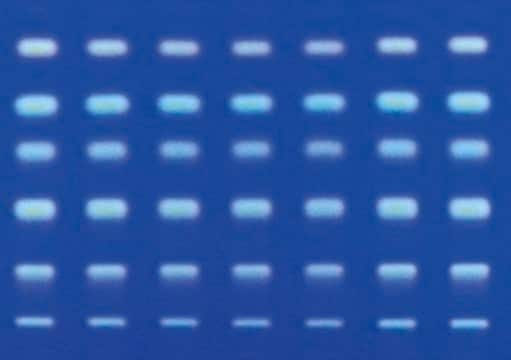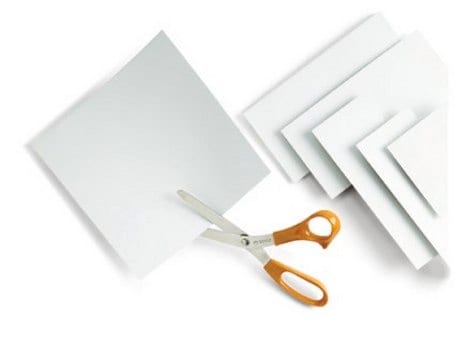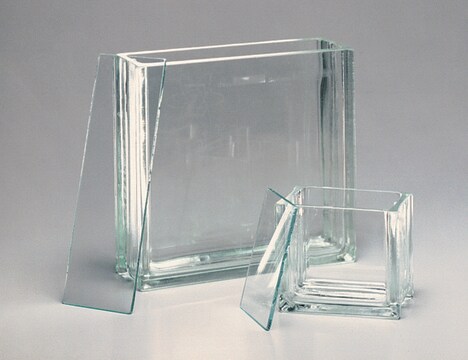1.14296
Płytki HPTLC, żel krzemionkowy 60 RP-18 W
pkg of 25 plates, plate L × W 20 cm × 10 cm, glass support
Synonim(y):
Wysokowydajne płytki TLC
Zaloguj sięWyświetlanie cen organizacyjnych i kontraktowych
About This Item
Kod UNSPSC:
41115711
NACRES:
NB.21
Polecane produkty
Materiały
glass support
silica gel 60 matrix
Poziom jakości
Właściwości
binder Organic Polymer
fluorescent indicator: no
opakowanie
pkg of 25 plates
metody
HPTLC: suitable
grubość warstwy
200 μm
płytka dł. × szer.
20 cm × 10 cm
wielkość cząstki
5-6 μm
wielkość porów
60 Å medium pore diameter
temp. przechowywania
2-30°C
Opis ogólny
25 Szklane paltes 10 x 20 cm
Płytki modyfikowane RP służą dwóm celom: działają jako metoda pilotażowa dla HPLC i pozwalają na wybór różnych systemów rozpuszczalników do specjalnych separacji. Nasze warstwy krzemionkowe modyfikowane metodą RP są dobrze dostosowane do wielu wyzwań związanych z separacją, których nie jest w stanie pokonać krzemionka niemodyfikowana. Warstwy te wykorzystują wodne układy rozpuszczalników do rozdzielania skrajnie niepolarnych substancji i analizowania konkretnych substancji polarnych, które można dostosować do chromatografii par jonowych. Co więcej, warstwy krzemionkowe modyfikowane metodą RP są mniej zależne od wilgotności powietrza. W przeciwieństwie do niemodyfikowanej krzemionki, fazy RP nie wykazują aktywności katalitycznej. To sprawia, że są one płytkami z wyboru dla niestabilnych substancji, które mają tendencję do degradacji oksydacyjnej.
Powiązanie
Zastępuje: 14296-6; 14296
Komentarz do analizy
Powierzchnia właściwa (wg BET; pomiar 5-punktowy): 480 - 540 m²/g
Objętość porów (N₂-izoterma): 0,74 - 0,84 ml/g
d 50 (dyfrakcja laserowa, rozkład wielkości): 5 - 7 µm
Grubość warstwy: 150 - 200 µm
Odchylenie grubości warstwy na płytkę: ≤ 35 µm
Badania chromatograficzne
Wartości hRf (cholesteryn, test cholesterynowy): 54 - 66
Objętość porów (N₂-izoterma): 0,74 - 0,84 ml/g
d 50 (dyfrakcja laserowa, rozkład wielkości): 5 - 7 µm
Grubość warstwy: 150 - 200 µm
Odchylenie grubości warstwy na płytkę: ≤ 35 µm
Badania chromatograficzne
Wartości hRf (cholesteryn, test cholesterynowy): 54 - 66
Ta strona może zawierać tekst przetłumaczony maszynowo.
produkt powiązany
Numer produktu
Opis
Cennik
Certyfikaty analizy (CoA)
Poszukaj Certyfikaty analizy (CoA), wpisując numer partii/serii produktów. Numery serii i partii można znaleźć na etykiecie produktu po słowach „seria” lub „partia”.
Masz już ten produkt?
Dokumenty związane z niedawno zakupionymi produktami zostały zamieszczone w Bibliotece dokumentów.
Nasz zespół naukowców ma doświadczenie we wszystkich obszarach badań, w tym w naukach przyrodniczych, materiałoznawstwie, syntezie chemicznej, chromatografii, analityce i wielu innych dziedzinach.
Skontaktuj się z zespołem ds. pomocy technicznej



